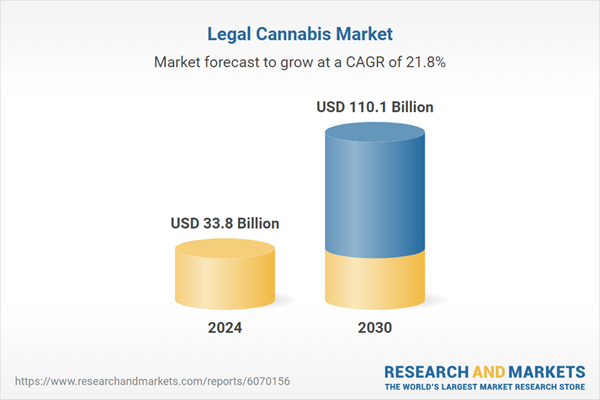Strong profit potential! The global legal cannabis market is expected to exceed $110 billion, and the cannabis pharmaceuticals market is expected to reach $72.7 billion by 2030.

According to a recent economic report published by Research and Markets analysts, the global legal Cannabis market is expected to experience significant growth.
Their latest market forecast highlights the strong profit potential of this emerging international industry. In a press release, Research and Markets stated, "The global legal cannabis market size was $33.8 billion in 2024 and is expected to reach $110.1 billion by 2030, growing at a compound annual growth rate (CAGR) of 21.8% from 2024 to 2030."

The press release states: "The global legal cannabis market has experienced unprecedented growth due to increasing legalization, growing medical applications, and changing consumer attitudes toward cannabis use. Governments around the world are recognizing the economic and medicinal potential of cannabis, which is driving broad and deep regulatory reforms."
The global legal marijuana market offers opportunities for expanding medical and wellness applications, fueled by growing consumer acceptance and regulatory changes. Significant growth areas include Cbd-based products, e-commerce, and sustainable cultivation methods, particularly in major markets such as the U.S., Canada, and China.
The press release also states that the legalization of cannabis for medical and recreational use in major markets such as the U.S., Canada, and parts of Europe has created significant business opportunities.
More than 100 countries have legalized medical marijuana, and industry models vary. Some models are very limited, allowing access only to specific portions of the product for certain conditions, while others offer multiple options for patients with various ailments.
Additionally, Uruguay, Canada, Malta, Luxembourg, Germany, and South Africa have legalized cannabis for adults at the national level, though not all of these countries currently permit the sale of cannabis to adults. Regional adult-use cannabis commercial pilot programs are underway in the Netherlands and Switzerland, and 24 states have approved recreational cannabis policies in the United States.
The emerging international legal marijuana industry comprises various segments and is expected to experience greater growth in some areas than in others in the future. Growing awareness of cannabis-derived compounds, such as cannabidiol (CBD) and tetrahydrocannabinol (THC), is spurring demand across industries including pharmaceuticals, healthcare, cosmetics, food, and beverages.
Cannabis beverages are becoming more available and popular in many legal markets. Coherent Market Insights recently predicted that the global cannabis beverages market size will reach $251.7 million in 2025 and $1,054.4 million by 2032. "
The cannabis pharmaceutical sector is another area of the industry with great potential. Many governments around the world only allow the sale of medicinal cannabis products within their jurisdictions.
According to a market analysis report by Research and Markets, the global cannabis pharmaceutical market is estimated to reach $72.7 billion by 2030, growing at a CAGR of 55.1% from 2024 to 2030.
A common regulatory requirement in the global legal cannabis market is testing cannabis products for contaminants and cannabinoid content. Cannabis testing requirements will likely be an important element of the legal marijuana trade in the future.
Economic researchers at Future Market Insights predict that the global automated marijuana testing market will significantly expand, with industry experts forecasting a compound annual growth rate (CAGR) of 11% to 13% from 2022 to 2032.
According to the report, the expansion of cannabis cultivation and the development of new products, such as foods, oils, tinctures, and infused beverages, has contributed to the growth of the market. Additionally, investments in cannabis research have led to new therapies for chronic pain, epilepsy, anxiety, and neurological disorders. The integration of technologies in cannabis cultivation and distribution, such as AI-powered crop monitoring and blockchain-enabled supply chain tracking, has improved operational efficiency. As the regulatory framework continues to evolve and consumer acceptance increases, the legal marijuana industry is expected to continue expanding.
Emerging Trends in the Legal Marijuana Industry
The legal cannabis industry is undergoing a major transformation, with several key trends shaping its future. One of the most notable trends is the increasing demand for cannabis-based health and wellness products, such as CBD-infused supplements, skincare products, and functional beverages. Another significant trend is the expansion of cannabis retail and e-commerce platforms, which increase consumer access to cannabis products through online sales and home delivery services. Premium and craft cannabis products have also gained traction as consumers seek high-quality, sustainably grown strains.
Additionally, the increasing use of cannabinoid ingredients in pet care products and CBD-based anxiety and pain relief therapies for animals are broadening the market. Advancements in cannabis cultivation techniques, such as hydroponics and vertical farming, are improving crop yields and product consistency. Additionally, the increase in corporate investments and mergers and acquisitions in the cannabis industry is accelerating consolidation and giving rise to multinational cannabis brands. As global regulatory frameworks evolve, cross-border cannabis trade and international market expansion are important growth drivers.
Growth Drivers in the Legal Marijuana Market
The growth of the legal cannabis market can be attributed to increasing legalization efforts around the world, expanding medical research, and growing consumer demand for cannabis-based health products. The growing popularity of marijuana as an alternative to traditional medicine has boosted sales of medical marijuana, and the recreational marijuana segment continues to attract new users. The expansion of cannabis retail infrastructure, including dispensaries and e-commerce platforms, has increased product accessibility.
Investments in cannabis technology, from genetic engineering to artificial intelligence analytics, have improved cultivation efficiency and product innovation. Additionally, the growing popularity of sustainable cannabis cultivation methods increases the market's appeal to environmentally conscious consumers. As cannabis legalization continues to advance, we expect the global legal cannabis market to grow exponentially in the coming years.
Challenges and obstacles remain.
Despite its strong growth, the legal cannabis market faces challenges that could affect its long-term expansion. One of the main hurdles is regulatory uncertainty, as marijuana laws vary widely across jurisdictions, creating compliance complexities for businesses. The continued stigmatization of cannabis use, especially in conservative areas, poses a significant obstacle to its mainstream acceptance. Additionally, cannabis businesses face banking and financial constraints due to federal regulations in certain states, limiting their access to traditional financing and payment processing services.
The illicit cannabis market will continue to compete with legal businesses because black market operators can offer lower prices and avoid taxes and regulatory costs. Inconsistent product quality and shortages may disrupt market stability on the supply chain side, and the lack of standardized testing and labeling requirements may raise concerns about product safety and efficacy.
Furthermore, the high tax and compliance costs associated with legal cannabis production may affect the profitability of small and medium-sized enterprises. Overcoming these challenges requires clear regulatory provisions, better consumer education, and continued industry collaboration to ensure sustainable market growth.











